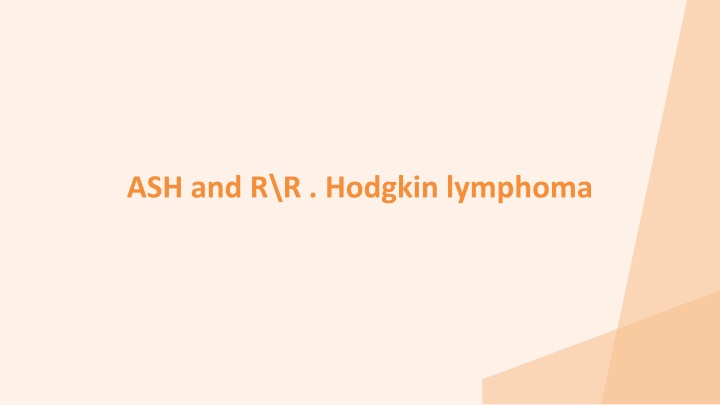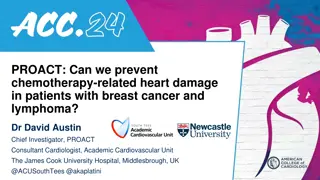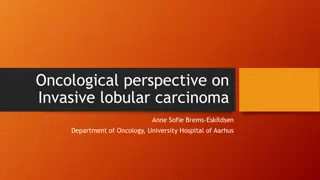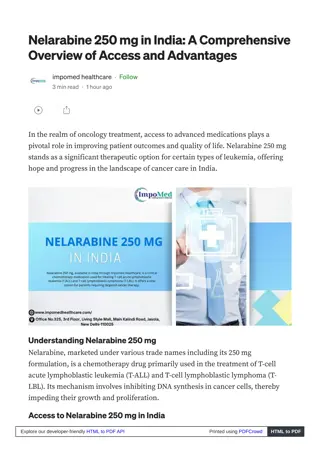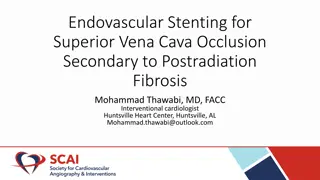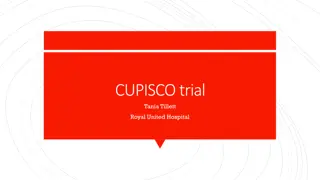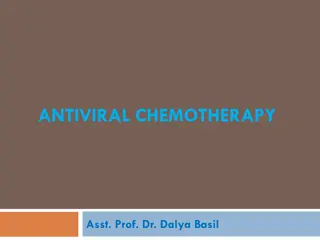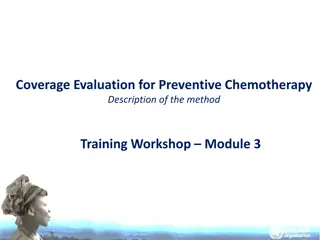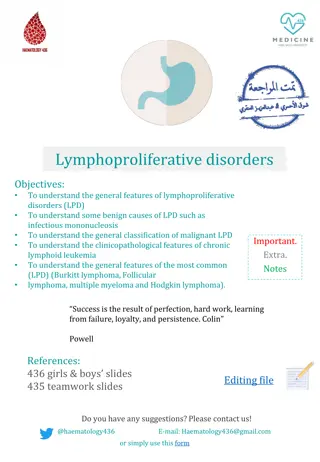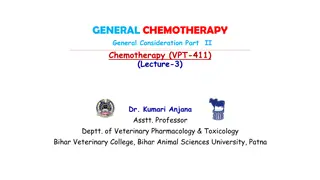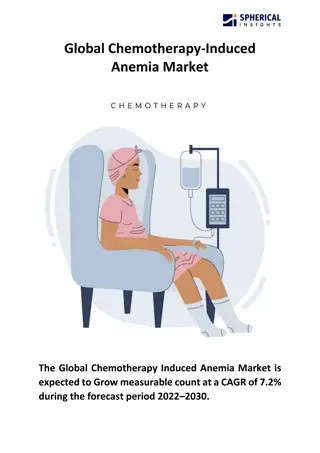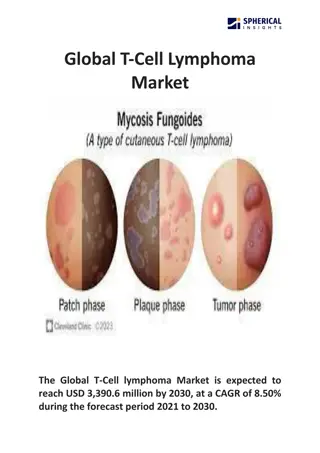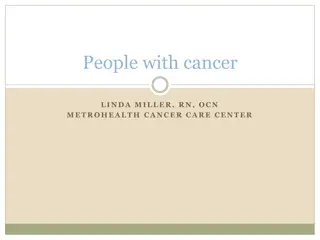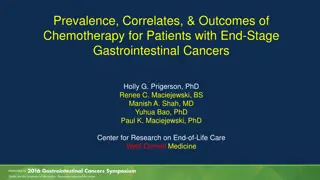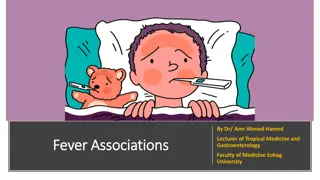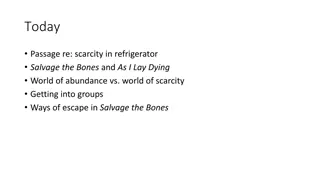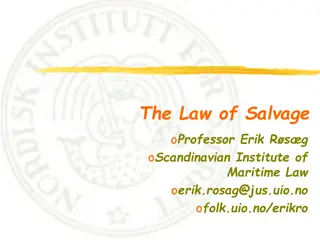Innovative Approaches in Salvage Chemotherapy for Hodgkin Lymphoma
Salvage chemotherapy plays a significant role in treating relapsed or refractory Hodgkin lymphoma patients before undergoing high-dose chemotherapy and autologous stem cell transplantation. Recent studies highlight the promising results of various salvage regimens, including functional imaging-based assessments and checkpoint inhibitor therapy. Explore how these innovative approaches are reshaping the treatment landscape for Hodgkin lymphoma patients.
Uploaded on Oct 04, 2024 | 1 Views
Download Presentation

Please find below an Image/Link to download the presentation.
The content on the website is provided AS IS for your information and personal use only. It may not be sold, licensed, or shared on other websites without obtaining consent from the author.If you encounter any issues during the download, it is possible that the publisher has removed the file from their server.
You are allowed to download the files provided on this website for personal or commercial use, subject to the condition that they are used lawfully. All files are the property of their respective owners.
The content on the website is provided AS IS for your information and personal use only. It may not be sold, licensed, or shared on other websites without obtaining consent from the author.
E N D
Presentation Transcript
Treatment for patients with a first relapse or primary refractory disease after first-line treatment Conventional salvage chemotherapy results in pre-ASCT complete response (CR) rates of about 20% to 25% and overall response rates (ORRs) of 60% to 70%, based on evaluation by CT scan. More recent studies reporting response rates based on functional imaging using PET or gallium showed CMR rates of 50% to 60% after ifosfamide, carboplatin, and etoposide (ICE) or etoposide, methylprednisolone, high-dose cytarabine, and cisplatin (ESHAP).
Even higher CMR rates were reported for the bendamustine, gemcitabine, and vinorelbine regimen (73%) and a sequential ICE gemcitabine, vinorelbine, and liposomal doxorubicin (GVD) approach (78%) in which patients with no CR on ICE received additional chemotherapy with GVD before proceeding to ASCT. However, randomized controlled trials (RCTs) comparing different salvage chemotherapy regimens or a PET adapted approach are lacking.
BV and checkpoint inhibitors BV is an anti-CD30 monoclonal antibody Conjugated to the microtubule- disrupting agent monomethyl auristatin-E. PD-L1 and PD-L2 are upregulated by HRS cells in about 90% of patients and induce T-cell exhaustion, which contributes to immune escape of HRS cells. CPIs are monoclonal antibodies that block the interaction between inhibitory ligands such as PDL1 and PD-L2 on the tumor cells and PD-1 receptors on immune effector cells.
High-dose chemotherapy and ASCT Superiority for HDCT/ASCT over mini-carmustine, etoposide, cytarabine, and melphalan (BEAM) (ie, reduced-dose BEAM without ASCT) in R/R cHL was shown in 2 randomized controlled trials (RCTs) in 1993 and 2002. However, in these trials, patients did not receive any salvage chemotherapy before BEAM or mini-BEAM. In addition, with the advent of effective drugs such as BV and CPIs, a subset of patients may be cured with salvage treatment alone.
A recently published study using pembrolizumab and GVD chemotherapy followed by HDCT/ASCT showed a very high pre-ASCT CMR rate of 95%, and with a median follow- up of 1 year, no progressions have occurred This study has now started a second part in which patients with a CMR after 2 cycles of pembrolizumab-GVD continue with 2 additional cycles of pembrolizumab-GVD followed by pembrolizumab consolidation instead of HDCT/ASCT. Results of this revolutionary approach could change the treatment of patients with R/R cHL significantly.
Patients with primary refractory disease Primary refractory disease and a short interval between first-line treatment and relapse are important poor prognostic factors for response to salvage therapy and PFS. CMR rates to salvage therapy for refractory patients are usually lower compared with relapsed patients However, in patients who do achieve a CMR to salvage therapy and proceed to ASCT, post-ASCT PFS for primary refractory and relapsed patients is similar.
A retrospective analysis In 78 patients who progressed on one or more salvage regimens and who were treated with regimens containing CPI showed favorable results, with 59% of patients achieving a CMR and a post-ASCT PFS of 81% at 18 months This suggests that treatment with CPI may improve chemosensitivity of previously chemorefractory disease. Interestingly, pre-ASCT CMR status was not significantly prognostic for post-ASCT PFS in this cohort, suggesting a PR might be sufficient for proceeding to ASCT after CPI in this patient population.
Patients with a late relapse Although most relapses after first-line treatment occur within the first 2 years, a minority of patients has a late relapse more than 5 years after first-line treatment. A large retrospective analysis showed that late relapses occur more frequently In patients with early-stage favorable disease compared With patients with unfavorable or advanced-stage disease.
Maintenance treatment after ASCT For patients with a high risk of relapse after ASCT, maintenance treatment with BV can be considered. 329 patients with unfavorable risk R/R CHL (defined as primary refractory disease, relapse <1 year, or extranodal disease) received either up to 16 cycles of BV maintenance or placebo after ASCT. The study showed improvement in PFS in patients receiving BV maintenance, with a 5-year PFS of 59% vs 41% for placebo. However, there was no difference in OS, probably because 87% of patients who relapsed in the placebo arm received BV at the subsequent relapse.
Therefore, the use of BV maintenance after ASCT could potentially be restricted to patients with at least 2 risk factors, or alternatively, its use could be delayed until progression. With the increasing use of BV in the first-line setting, it is also important to investigate whether patients who relapse after BV in combination with chemotherapy will still show advantage of BV maintenance after ASCT. Alternatively, CPI could be used as maintenance treatment; a small phase 2 trial in 30 high-risk patients showed high post-ASCT PFS. The combination of CPI and BV maintenance in 59 high risk patients has also shown promising results, with 5 patients with PR converting to CR during maintenance.
BV and CPI treatment for patients who relapse after ASCT or are ineligible for ASCT The first breakthrough in the post-ASCT setting was the application of monotherapy with BV in heavily pretreated R/R patients, which showed an ORR of 75% and a CMR rate of 34% with a median PFS of 20.5 months in those with a CMR. The PFS rate at 5 years, however, was only 22% with an OS of 41%, highlighting the need for additional treatment options
A study that investigated pembrolizumab monotherapy showed an ORR of 69% and a CMR rate of 22%, with a 2-year PFS of 31% and OS of 91%. In a phase 1 trial, 64 patients were randomized between ipilimumab-BV, nivolumab-BV, and triple therapy with ipilimumab-nivolumab-BV. The trial showed differences in toxicity profile and efficacy between the 3 regimens, with the highest percentage of grade 3/4 adverse events in the triplet and ipilimumab-BV group, whereas the highest ORR and CMR rates were found in the triplet and nivolumab-BV group.
Salvage options in double-refractory cHL Conventional cytotoxic therapy options in a fit patient conventional multiagent chemotherapy as a bridge to allogeneic (allo) HCT is a reasonable option. In patients who are not candidates for allo-HCT, single-agent cytotoxic therapy with a palliative intent is reasonable. The choice of chemotherapy (regimen) is often empiric and depends on the patient s prior treatments, marrow reserve, and organ function.
Investigational agents for double- refractory cHL Camidanlumab tesirine (cami) is an antibody-drug conjugate (pyrrolobenzodiazepine) directed against CD25. a phase 2 study was conducted using 45 g/kg q3 week Dosing for two cycles followed by 30 g/kg Q3 weeks (in cHL with prior BV and CPI treatments). Cami was active in R/R cHL patients based on the preliminary results (n = 51), with an overall response rate (ORR) of 83% and a complete response (CR) rate of 38%. Grade 3 or higher adverse events were reported in 63% (n = 32) of cHL patients.
Of note, there were 3 (6.4%) patients with Guillain-Barre syndrome (GBS)/polyradiculopathy (n = 1 with grade 4 GBS, n = 1 with grade 2 GBS, and n = 1 with grade 2 radiculopathy) that led to an enrollment pause. Following a review of safety and efficacy data (by independent review), the enrollment pause was lifted. The study recently completed accrual, and final results are not yet available. but the preliminary results with cami are encouraging and may provide an additional therapeutic option for patients with R/R cHL, particularly those with dual-refractory disease.
Mammalian target of rapamycin inhibitors Everolimus is an oral inhibitor of mTOR that is active in R/R cHL. In a phase 1/2 study of heavily pretreated cHL patients (n = 15), the combination of everolimus and itacitinib (an oral Jak inhibitor) produced an ORR and CR rate of 79% and 14%, respectively. Of note, 94% (n = 14) were double refractory in the study. The notable grade 3 or higher toxicities included thrombocytopenia (43%), neutropenia (21%), infection (7%), and hypertension (7%).
Transplant and cellular therapy options Allogeneic HCT Historically, allo-HCT in R/R cHL has been associated with high rates of nonrelapse mortality (NRM; 35%-45% at 1 year) and disease relapse (up to 50%). These rates (with an obvious negative impact on referral patterns) and the availability of novel agents in cHL have led to a decline in the use of allo-HCT in cHL in the US in the last decade However, in dual refractory cHL, the role of allo-HCT warrants reappraisal, especially when focusing on modern outcome data from the CIBMTR showing remarkable improvement in survival outcomes
Cellular therapies In a phase 1/2 study of heavily pretreated cHL (median prior lines = 7) including BV, CPI, auto-HCT, and/or allo-HCT, CD30.CAR-T cell therapy was safe and well tolerated The ORR was 72% in those receiving fludarabine-based lymphodepletion (n = 31) with a CR rate of 59%, but 1-year progression free survival was only 36%. Currently, a larger phase 2 study is ongoing to evaluate the efficacy of CD30.CAR- T cells in R/R cHL (NCT04268706).
Epstein-Barr virus (EBV)-directed cytotoxic T cells (CTLs) directed against LMP 1 and LMP 2 have activity in EBV+ cHL In patients with EBV-associated cHL and NHL, CTLs with enhanced activity against LMP 1/2 were tested with promising results, wherein a response to therapy was noted in 13 of 21 patients with active disease, including 11 patients achieving CR. Currently, a phase 1 study using EBV CTLs expressing CD30 chimeric receptor for CD30+ lymphomas is ongoing (NCT01192464).
AFM13 induces the specific and selective killing of CD30+ cells by engaging CD16 on natural killer (NK) cells and CD30 on the surface of the cHL cells (bispecific NK cell engagers, or BIKEs). It has been combined with CPI (AFM13+ pembrolizumab in CPI-naive R/R cHL) and with cytokine activated cord blood-derived NK cells. The preliminary safety and efficacy data on first-in-human cord blood-derived NK BIKEs (CD16A/CD30) in heavily pretreated cHL (n = 4) are provocative.The ORR/CR rate was 100% and 50%, respectively, with no evidence of cytokine release syndrome, neurotoxicity, or GVHD noted. Currently, the study is enrolling Patients (NCT04074746).
